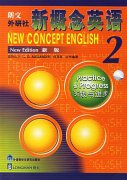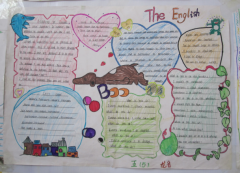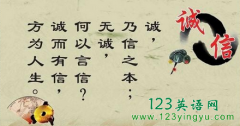高考英语复习:情态动词
编辑:高中作文网情态动词
情态动词表示说话人对某一动作或状态的态度,可以表示"可能"、"可以"、"需要"、"必须"或"应当"等之意。情态动词没有人称和数的变化。但不能单独作谓语动词用,必须和不带to的不定式连用构成谓语动词。只有情态动词ought要和带to的动词不定式连用,在句中作谓语用。
将情态动词置于主语之前即构成其疑问式,在情态动词之后加not既构成其否定式。现将各情态动词的基本用法分述如下:
1、can和could (could为can的过去式) 的基本用法
(1)表示能力,如:He can speak English better than you. (2)在疑问句和否定句中表示"怀疑"、"猜测"或"可能性",如:Can this green bike be Liu Dong's? (3)表示"许可"时can可以和may换用,如:You can (may) go home now. (4)如果要表示语气婉转,可用could代替can,这时could不再是can的过去式,如:Could you come again tomorrow? (5)can和be able to都可表示能力,两者在意思上没有什么区别。但是can只能有现在式和过去式,而be able to则有更多的形式,如:He will be able to do the work better.
2、may和might (might为may的过去式)的基本用法
(1)表示允许或征询对方许可,有"可以"之意,如:You may use my dictionary. 在回答对方说"可以做某事"或"不可以做某事"时,一般多不用may或 may not,以避免语气生硬或不容气。而用比较婉转的说法进行回答。如:---- May I use this dictionary? ---- Yes, please. 或 ---- Certainly. 在请求对方许可时,如果Might I…? 就比用May I…? 语气更婉转些,如:May I have a look at your new computer? 但是表示"阻止"或"禁止"对方做某事时,要用must not代替may not,如:---- May we swim in this lake? ---- No, you mustn't. It's too dangerous. (2)may或 might都可以表示可能性,表示"或许"、"可能"之意,如果用might表示可能性,则语气更加不肯定,如:They may (might) be in the library now .
3、must的基本用法
(1)must表示"必须"、"应该"之意,其否定式 must not,缩写形式为 mustn't,表示"不应该","不准"、"不许可"或"禁止"之意,如:We must study hard and make progress every day. You mustn't touch the fire. (2)对以must提出的疑问句,如作否定回答时,要用needn't或用don't (doesn't) have to (不 必)来回答,而不用mustn't,因为mustn't表示的是"禁止"或"不许可"之意,如:---- Must we finish the work tomorrow? ---- No, you needn't (don't have to), but you must finish it in three days. (3)在肯定句中must可以表示推测,表示"一定"或"必定"之意,如:---- Whose new bike can it be? ---- It must be Liu Dong's. I know his father has just bought him a new one.
4、can, could, may, must后接完成式的用法
(1)can, could后接完成式的用法:①在否定句或疑问句中表示对过去发生过的事情的"怀疑"或"不肯定"的态度,Could he have said so? ②在肯定句中,可以表示过去可能做到而实际并没做到的事情,有"劝告"或"责备"的语气。如:---- When did you answer her letter? ---- Only yesterday. ---- It's too late. You could have answered it earlier, I am sure. (2)may, might后接完成式的用法 ①表示对过去某事的推测,认为某一件事情在过去可能发生了。如果使用might,语气就比较婉转或更加不肯定,如:Mary might have learned some Chinese before. ②可以表示过去本来可以做到而实 际没有做到的事情,有"劝告"或"责备"的语气,如:You didn't do the work well that day. You might have done it better. (3)must后接完成式的用法:表示对过去某事的推测,认为某事在过去一定做到 了,如:Liu Dong isn't in the classroom. He must have gone to the library.
5、have to 的基本用法:have to和must的意义相近,只是 must侧重表示说话人的主观看法,而have to 则表示客观需要,如:I must study hard. I had to give it up because of illness.
6、ought to的基本用法
(l)表示根据某种义务或必要"应当"做某事,语气比should强,例如:Everyone ought to obey the traffic regulations. (2)表示推测,注意与must表示推测时的区别:He must be home by now .(断定他已到家),He ought to be home by now .(不十分肯定),This is where the oil must be.(比较直率) ,This is where the oil ought to be. (比较含蓄) ;(3)"ought + have+ 过去分词"表示过去应做某事而 实际未做。例如:You ought to have helped him. (but you didn't) 这时,ought与 should可以互相换用。注意,在美国英语中ought to 用于否定和疑问句时to可以省略。例如:Ought you smoke so much? You oughtn't smoke so much.
7、dare的基本用法
(l)dare (dared为其过去式) 作情态动词用时,主要用于否定句,疑问句和条件从句中,如:Dared he bread the traffic regulations again? (2)在现代英语中dare常用作行为动词,其变化与一般行为动词相同,如:She dares to stay at home alone at night.
8、need的基本用法
(1)need作情态动词用时,主要用于否定句和疑问句中,如:He needn't worry about us now. (2)need也可作为行为动词用,可用于肯定句,否定句和疑问句中,其后可接名词、代词、动名词或带 to 的动词不定式为其宾语。如:You need to practise reading aloud every day. (3)needn't后接完成式可以表示过去做了一件本来不必要做的事情,如:---- Did you answer the letter yesterday? ---- Yes, I did. ---- But you needn't have answered it.
9、shall的基本用法
(1)shall用作情态动词时,用于第二、三人称,表示说活人的意愿,可表示"命令"、"警告"、"强制"、"威胁"或"允诺"等意,如:He shall go first, whether he wants to or not. (2)在疑问句中,shall用于第一、三人称,表示说话人的征询对方意见或请求指示,如:Shall I open the door?
10、should的基本用法
(1)should作为情态动词可以表示"建议"或"劝告",有"应该"之意,如:You should learn from each other. (2)should后接完成式表示过去没有做到本来应该做的事情,或是做了本来不应该做的事情。如:You should have give him more help.
11、will的基本用法
(1)用于各人称,可以表示"意志"或"决心",如:I have told him again and again to stop smoking, but he will not listen. (2)在疑问句中用于第二人称,表示说话人向对方提出请求或询问对方的意愿,如:Will you please tell me how to get to the Capital Gymnasium? (3)will可以表示一种习惯性的动作,有"总是"或"会要"之意,如:Every morning he will have a walk along this river.
12、would的基本用法
(1)would作为will的过去式,可用于各人称,表示过去时间的"意志"或"决心",如:He promised he would never smoke again. (2)在疑问句中,用于第二人称,表示说话人向对方提出请求或许问对方的意愿时,比用will的气更加婉转,如:Would you like some more coffee? (3)在日常生活中,学用"I would like to…"表示"我想要"或"我愿意"之意,以使语气婉转,如:I would like to do Ex.2 first. (4)would可以表示过去的习惯动作,比used to正式,并没有"现已无此习惯"的含义。如:Last year our English teacher would sometimes tell us stories in English after class. / During the vacation he would visit me every week. (5)表料想或猜想,如:It would be about ten when he left home./ What would she be doing there?/ I thought he would have told you about it.
13、used to, had better, would rather的用法
(1)used to表示过去的习惯动作或状态,现在已不存在,在间接引语中,其形式可不变,例如:He told us he used to play foot ball when he was young. 在疑问句、否定句、否定疑问句或强调句中,可有两种形式。疑问句:Did you use to/ Used you to go to the same school as your brother? 否定句:I usedn't to / didn't use to go there. (usedn't 也可写作usen't);否定疑问句:Usen't you to/ Didn't you use to be interested in the theatre? 强调句:I certainly used to/ did use to smoke, but it was a long time ago.;其反意疑问句或简略回答中,也有两种形式:She used to be very fat. didn't she?/ use(d)n't she? Did you use to play chess? Yes, I did./ Used you to get up early in the morning? Yes, I did./ used to. (2)had better意为"最好",后接不带to的不定式,例如:---- We had better go now . ---- Yes, we had (we'd better/ we had better)./ Hadn't we better stop now? (Had we better not stop now?)/ I think I'd better be going. (用于进行时态,表"最好立即")/ You had better have done that (用于完成时态,表未完成动作) 注:had better用于同辈或小辈,对长辈不可用。(3)would rather意为"宁愿",表选择,后接不带to的不定式,例如:I'd rather not say anything./ Would you rather work on a farm?/ ---- Wouldn't you rather stay here? ---- No, I would not. I'd rather go there. 由于would rather表选择,因 而后可接than,例如:I would rather work on a farm than in a factory. / I would rather watch TV than go to see the film/ I would rather lose a dozen cherry trees than that you should tell me one lie./ I'd rather you didn't talk about this to anyone. (句中的 'd rather不是情态动词,would 在此是表愿望的实义动词) 情态动词
情态动词表示说话人对某一动作或状态的态度,可以表示"可能"、"可以"、"需要"、"必须"或"应当"等之意。情态动词没有人称和数的变化。但不能单独作谓语动词用,必须和不带to的不定式连用构成谓语动词。只有情态动词ought要和带to的动词不定式连用,在句中作谓语用。
将情态动词置于主语之前即构成其疑问式,在情态动词之后加not既构成其否定式。现将各情态动词的基本用法分述如下:
1、can和could (could为can的过去式) 的基本用法
(1)表示能力,如:He can speak English better than you. (2)在疑问句和否定句中表示"怀疑"、"猜测"或"可能性",如:Can this green bike be Liu Dong's? (3)表示"许可"时can可以和may换用,如:You can (may) go home now. (4)如果要表示语气婉转,可用could代替can,这时could不再是can的过去式,如:Could you come again tomorrow? (5)can和be able to都可表示能力,两者在意思上没有什么区别。但是can只能有现在式和过去式,而be able to则有更多的形式,如:He will be able to do the work better.
2、may和might (might为may的过去式)的基本用法
(1)表示允许或征询对方许可,有"可以"之意,如:You may use my dictionary. 在回答对方说"可以做某事"或"不可以做某事"时,一般多不用may或 may not,以避免语气生硬或不容气。而用比较婉转的说法进行回答。如:---- May I use this dictionary? ---- Yes, please. 或 ---- Certainly. 在请求对方许可时,如果Might I…? 就比用May I…? 语气更婉转些,如:May I have a look at your new computer? 但是表示"阻止"或"禁止"对方做某事时,要用must not代替may not,如:---- May we swim in this lake? ---- No, you mustn't. It's too dangerous. (2)may或 might都可以表示可能性,表示"或许"、"可能"之意,如果用might表示可能性,则语气更加不肯定,如:They may (might) be in the library now .
3、must的基本用法
(1)must表示"必须"、"应该"之意,其否定式 must not,缩写形式为 mustn't,表示"不应该","不准"、"不许可"或"禁止"之意,如:We must study hard and make progress every day. You mustn't touch the fire. (2)对以must提出的疑问句,如作否定回答时,要用needn't或用don't (doesn't) have to (不 必)来回答,而不用mustn't,因为mustn't表示的是"禁止"或"不许可"之意,如:---- Must we finish the work tomorrow? ---- No, you needn't (don't have to), but you must finish it in three days. (3)在肯定句中must可以表示推测,表示"一定"或"必定"之意,如:---- Whose new bike can it be? ---- It must be Liu Dong's. I know his father has just bought him a new one.
4、can, could, may, must后接完成式的用法
(1)can, could后接完成式的用法:①在否定句或疑问句中表示对过去发生过的事情的"怀疑"或"不肯定"的态度,Could he have said so? ②在肯定句中,可以表示过去可能做到而实际并没做到的事情,有"劝告"或"责备"的语气。如:---- When did you answer her letter? ---- Only yesterday. ---- It's too late. You could have answered it earlier, I am sure. (2)may, might后接完成式的用法 ①表示对过去某事的推测,认为某一件事情在过去可能发生了。如果使用might,语气就比较婉转或更加不肯定,如:Mary might have learned some Chinese before. ②可以表示过去本来可以做到而实 际没有做到的事情,有"劝告"或"责备"的语气,如:You didn't do the work well that day. You might have done it better. (3)must后接完成式的用法:表示对过去某事的推测,认为某事在过去一定做到 了,如:Liu Dong isn't in the classroom. He must have gone to the library.
5、have to 的基本用法:have to和must的意义相近,只是 must侧重表示说话人的主观看法,而have to 则表示客观需要,如:I must study hard. I had to give it up because of illness.
6、ought to的基本用法
(l)表示根据某种义务或必要"应当"做某事,语气比should强,例如:Everyone ought to obey the traffic regulations. (2)表示推测,注意与must表示推测时的区别:He must be home by now .(断定他已到家),He ought to be home by now .(不十分肯定),This is where the oil must be.(比较直率) ,This is where the oil ought to be. (比较含蓄) ;(3)"ought + have+ 过去分词"表示过去应做某事而 实际未做。例如:You ought to have helped him. (but you didn't) 这时,ought与 should可以互相换用。注意,在美国英语中ought to 用于否定和疑问句时to可以省略。例如:Ought you smoke so much? You oughtn't smoke so much.
7、dare的基本用法
(l)dare (dared为其过去式) 作情态动词用时,主要用于否定句,疑问句和条件从句中,如:Dared he bread the traffic regulations again? (2)在现代英语中dare常用作行为动词,其变化与一般行为动词相同,如:She dares to stay at home alone at night.








